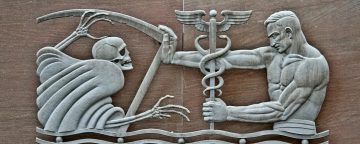Aaron Kheriaty in The Scientist:
 On June 9, 2016, a law permitting physician-assisted suicide went into effect in California. The same day, Dr. Lonny Shavelson, an emergency medicine physician, opened the Bay Area End of Life Options clinic to provide the newly legal service. A longtime activist for the cause, Shavelson’s interest began in adolescence. In an interview last year, he describes how, when he was fourteen, his severely depressed mother “enrolled me in pacts for her death.” Despite acknowledging that her request was “pathological,” he eventually chose to become a doctor “not only to help her in her illness but also to help her die.” In his 1995 book A Chosen Death, Shavelson recounted underground assisted suicides he witnessed. In one case, “Sarah,” the leader of a local advocacy group, took an especially active role when “Gene,” an elderly, partially paralyzed alcoholic man, asked for help with ending his life. But things did not go as planned, when Gene jolted awake in the middle of the process:
On June 9, 2016, a law permitting physician-assisted suicide went into effect in California. The same day, Dr. Lonny Shavelson, an emergency medicine physician, opened the Bay Area End of Life Options clinic to provide the newly legal service. A longtime activist for the cause, Shavelson’s interest began in adolescence. In an interview last year, he describes how, when he was fourteen, his severely depressed mother “enrolled me in pacts for her death.” Despite acknowledging that her request was “pathological,” he eventually chose to become a doctor “not only to help her in her illness but also to help her die.” In his 1995 book A Chosen Death, Shavelson recounted underground assisted suicides he witnessed. In one case, “Sarah,” the leader of a local advocacy group, took an especially active role when “Gene,” an elderly, partially paralyzed alcoholic man, asked for help with ending his life. But things did not go as planned, when Gene jolted awake in the middle of the process:
“It’s cold,” he screamed, and his good hand flew up to tear off the plastic bag. Sarah’s hand caught Gene’s at the wrist and held it. His body thrust upwards. She pulled his arm away and lay across Gene’s shoulders. Sarah rocked back and forth, pinning him down, her fingers twisting the bag to seal it tight at his neck as she repeated, “The light, Gene, go toward the light.” Gene’s body pushed against Sarah’s. Then he stopped moving.
Shavelson watched, frozen with ambivalence at whether to intervene. He did not.
Shavelson seems to have taken away from this event a sense of the dire need for reliable methods for ending life. Ignorance of these methods, he argued in last year’s interview, was much of what motivated doctors to oppose assisted suicide:
Everybody I talked to said we don’t know how to do this. So we don’t agree with it. And over time, what’s wonderful to watch is how patients have been the leading force…. As [hospices] started getting patient requests, they couldn’t just keep saying no. Hospices are fundamentally a loving and caring and responsive organization.
He and his colleagues have thus made themselves “ambassadors,” training physicians around the state on proper suicide methods to meet patient demand. As of last November, Dr. Shavelson and his staff had been at the bedside of 114 people whose suicides they assisted.
More here.
